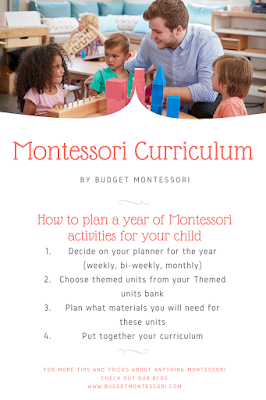How I Planned My Child's Montessori Curriculum in 4 Steps
Hi there, welcome or welcome back!
Today's post is about how I planned a year worth of Montessori lessons for my child. At first I thought that it was a very daunting task, but I sat down, took a deep breath and tackled it head on. I will teach you everything that you need to know so that you can create your own Montessori curriculum stress-free. By using this technique you can plan a new Montessori curriculum every year!
I've created a Montessori yearly planner template that you can download here and use to plan your lessons for your child. Print it out and let's get started...
The goal: Provide you with the basics that will enable you to create your child's Montessori curriculum in a time-saving and hassle-free manner.
You need to understand the basis of the curriculum. There are the 5 working/learning areas (in regular terms, 'subjects') that your child needs to cover over the course of the year.
✩ Practical Life - Care of self, others and the environment. It includes activities such as, washing hands and arranging flowers. It develops a child's coordination and control of movement, as well as self-discipline.
✩ Sensorial - Young children learn mostly through their senses rather than intellect. It refines their senses as they work on smell, size, flavour and more. Hands-on activities are the best ways to learn. It develops their capacity of perception and favours observation.
✩ Mathematics - Learning and understanding mathematical concepts. Children manipulate material teaching them number value etc. It develops their math ability and thus setting the foundation for algebra and geometric concepts.
✩ Language - Enriches their language skills with writing and reading. Children work on letter sounds and penmanship. They use material such as the moveable alphabet. It develops everything to do with fluency and ability to express themselves using their words.
✩ Culture - Learning about geography, history, art and music thus exploring the world. This is such a vast learning area and it develops a child's love and appreciation for their surroundings, others and things.
You should keep in mind that Montessori is hands-on and involves concrete learning. Learning isn't a process and is not determined by a child's age but rather by the speed at which a child can acquire a skill before moving to the next one. Activities utilize the child's senses and have control of error.
This is the part that I enjoy the most and this is the actual planning!
➯ Decide on a the structure of your planner (in other words, decide on how long each theme will be taught): There are several ways to do this. You can create a curriculum that focuses on one theme:
◾ Weekly
◾ Bi-weekly
◾ Monthly (one theme - 4 subcategories)
You decide on whichever you feel that your child will thrive on and be interested in. I personally chose to do my themes weekly, as it provides enough exposure to the theme and maintains my child's attention.
➯Choose your themed units: This is where you select which themes you want to introduce. I recommend using a list of themed units and mixing
and matching them, as you fill out your curriculum. For example, a unit
can be on 'plants' which you can introduce during the first weeks of
summer. The list can be used over and over as your child develops. You
simply tweak the activities related to the theme to suit your child's
level. This means that you basically have several years of content for
your child! I created a 'Themed Units Bank' which includes over 25+ themes, such as units on the ocean and human anatomy. I obviously spent over an hour creating it but once it was done, I was able to update it regularly (to always have fresh content) and use it for other curricula.
➯ Select the material needed: The material needed varies on the activities linked to each theme. This does not include however the basic materials of Montessori education such as the bead stair, spindle boxes, pink tower etc. What I mean are really specific materials related to what you chose to present to your child. For example, if I am going to introduce gardening for the week I would put on my list of items seeds, and a watering can. Material can be quite expensive so do not hesitate to DIY your own materials at home or use other things that give the same result.
➯Put together your curriculum: Now that you have decided on the type of planner, themes and materials you write everything down into your planner. Go over your curriculum a second time to make sure that everything is at your child's level and interest. Voila! There you go, you are done!
Here is what I planned for 2020:
You will see that there are themes related to holidays throughout the year, as well as themes that are revisited several times but the subcategory is different. For example, I chose Christmas related activities in December and the theme of animals was split, focusing on different animals separately. This is just a snippet of 3 months to give you an example.
** Keep in mind that you are 'following' your child, so if they are not interested you can always pick up the theme or activity at a later time. Think of it as a fluid curriculum.
I hope that you appreciated this post. Remember to subscribe to my blog as there will be more exciting and worthy posts coming up about creating your child's yearly curriculum. My Etsy shop will soon have a full planner (new edition) and my 'themed units bank' for sale!
See you next Tuesday!



Comments
Post a Comment